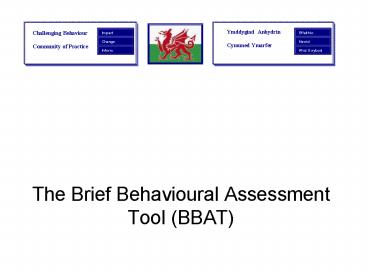The Brief Behavioural Assessment Tool (BBAT) - PowerPoint PPT Presentation
1 / 14
Title:
The Brief Behavioural Assessment Tool (BBAT)
Description:
Ymddygiad Anhydrin Cymuned Ymarfer Challenging Behaviour Community of Practice Impact Effeithio Change Newid Inform Rhoi Gwybod The Brief Behavioural Assessment Tool ... – PowerPoint PPT presentation
Number of Views:2932
Avg rating:3.0/5.0
Title: The Brief Behavioural Assessment Tool (BBAT)
1
The Brief Behavioural Assessment Tool (BBAT)
Ymddygiad Anhydrin Cymuned Ymarfer
Challenging Behaviour Community of Practice
Impact
Effeithio
Change
Newid
Inform
Rhoi Gwybod
2
Acknowledgements
- The BBAT was developed by
- Dr Mark Smith Consultant Clinical Psychologist
- Dr Gill Nethell, Clinical Psychologist
- Professor Dave Allen, Associate Clinical Director
- With input from
- Dr Edwin Jones, Service Development Consultant
- Special Projects Team,
- Directorate of Learning Disability Services,
- Abertawe Bro Morgannwg University Health Board
3
Local context- ABM
- Challenging behaviour care pathway- variation in
assessments and interventions offered for CB - Admissions to Acute Assessment and Treatment
Units- no standard product on discharge - Training needs identified at T2 and T3
- Our overall agenda- improving competency and
raising the bar of basic assessment skills
4
Brief functional analysis
- Comprehensive functional analysis should always
be the gold standard, but may not always be
needed or practical - Low level CB
- Isolated behaviour that occurs in a specific
context - When comprehensive assessment already undertaken
but needs to be reviewed - When there is a need to put interim strategies in
place due to risks - Family settings
- Short admissions to AATU
5
Other brief assessment tools
- Some brief behavioural assessment tools already
published, e.g. Functional Analysis Screening
Tool (Iwata, 1995) - But FAST is very brief (2 pages), and doesnt
include some key questions that we tend to ask - So the BBAT was born!
6
What is the BBAT?
- Informant based assessment tool to use in
functional analysis - Explores key areas that are usually assessed
using multiple tools such as FAI, MAS, CAI, RI etc
7
BBAT is designed to help you
- ? Clearly define behaviour(s) of concern
- ? Identify key triggers- slow and fast
- ? Identify possible maintaining consequences
- ? Identify whether the person is able to use
alternative responses, other than their
challenging behaviour, so that you can build on
these - ? Identify the persons main preferences, so
that you can use these to reinforce
non-challenging behaviour - ? Identify the persons basic communication
skills
8
What it looks like
- 8 pages
- Takes approximately 1 hour-1hour 30 mins to
complete - 8 sections
- Informant/service user relationship
- Defining and prioritising the behaviours of
concern (over last 12 months) - When is behaviour most likely to occur (slow and
fast triggers) - Early indicators
- Possible maintaining consequences
- Coping skills
- Basic communication skills
- Likes and preferences
- Summary tables
9
Limitations
- Not a replacement for a comprehensive assessment
- Caution required when used in isolation
- Advisable to back up findings with some form of
observational data as a minimum standard
10
ABMU brief assessment process
- Informant based assessment
- BBAT
- Pre-post measures of change
- ABC
- PAS-ADD
- HoNOS
- Direct observational data
- Behaviour Monitoring Form (BMF)
11
Reliability and validity
- Comparing brief v comprehensive functional
analysis in Specialist Residential Services - Initial results suggest 75 overlap in brief
and comprehensive functional analysis when using
BBAT
12
Factor analysis
- Factor analysis of the 20 items on maintaining
functions - Factor analysis of 126 BBATs indicates that at
least 16 out of the 20 questions load solely onto
the factors they were intended to with a loading
greater than 0.4
13
Implementation
- All ABMU -AATU staff trained in administration of
BBAT, which is now used as part of all admissions - Training planned for Tier 2 services in
ABMU--BBAT will form part of minimum standard
within the Care Pathway - Trained small group of 3rd sector staff to
successfully use BBAT - Aneurin Bevan UHB training staff as above
- Betsi Cadwalladr UHB training staff
- Very positive feedback !!
14
BBAT training
- Training led by developers of BBAT
- Training on the whole brief assessment process
- Competency based approach
- Learning how to use the tool
- Opportunity to practice
- Using the tool in situ
- Receiving feedback from a mentor
- Learning how to develop an intervention































